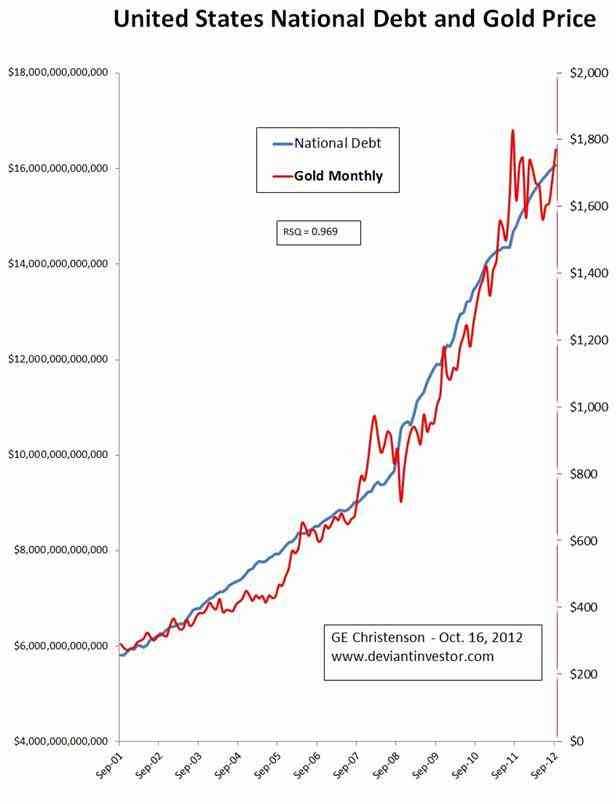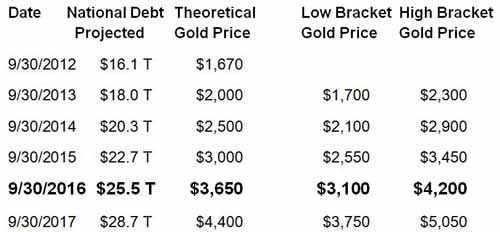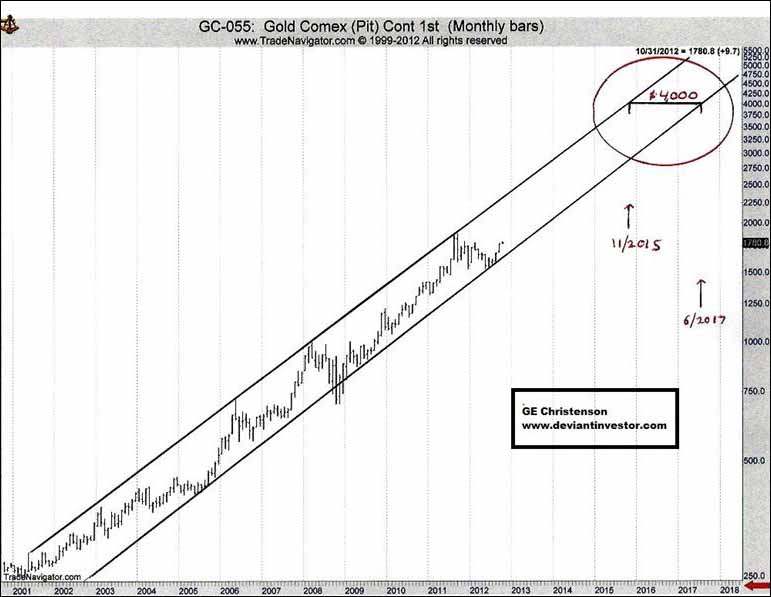Gold $4,000! Yes, But When?
Commodities / Gold and Silver 2012 Nov 05, 2012 - 09:57 AM GMTBy: DeviantInvestor
 There are hundreds of predictions for the price of gold. Some say it will crash to nearly $1,000, and others proclaim $3,000 by the end of 2012. The problem is that some predictions are only wishful thinking, others are obvious disinformation designed to scare investors away from gold, and many are not grounded in hard data and clear analysis. Other analysis is excellent, but both the process and analysis are difficult to understand. Is there an objective and rational method to project a future gold price that will make sense to most people?
There are hundreds of predictions for the price of gold. Some say it will crash to nearly $1,000, and others proclaim $3,000 by the end of 2012. The problem is that some predictions are only wishful thinking, others are obvious disinformation designed to scare investors away from gold, and many are not grounded in hard data and clear analysis. Other analysis is excellent, but both the process and analysis are difficult to understand. Is there an objective and rational method to project a future gold price that will make sense to most people?
Yes, there is!
I am not predicting a future price of gold or the date that gold will trade at $4,000, but I am making a projection based on rational analysis that indicates a likely time period for gold to trade at $4,000 per ounce. Yes, $4,000 gold is completely plausible if you assume the following:
- The US government will continue to spend in excess of $1 Trillion per year more than it collects in revenue, as it has done for the previous four years, and as the government budget projects for many more years.
- Our financial world continues on its current path of deficit spending, debt monetization, Quantitative Easing (QE), weaker currencies, war and welfare, ballooning debts, and business as usual.
- A massive and devastating financial and economic melt-down does NOT occur in the next four to six years. If such a melt-down occurs, the price of gold could skyrocket during hyperinflation or stagnate under a deflationary depression scenario.
Still with me? I think most people will accept these simple and rather obvious assumptions.
Many individuals find it difficult to believe any projections for gold, either higher or lower, because gold is hated, loved, often ignored, and seldom understood or recognized as the ultimate currency. However, most people know that the US government national debt is huge and will grow much larger during the next decade. Examine the following graph:

National debt is plotted on the left axis – yes, it was larger than $16 Trillion as of September 30, 2012. Gold is plotted on the right axis. The data covers an 11 year span from September 2001 through September 2012. This period includes the time after the stock market crash of 2000, the game-changing events of 9-11, the real estate crash, and the new bull market in commodities. Each month represents one data point. Note the similarity between the two trends. The statistical measure R-Squared for this 11 year period of monthly data is 0.969 – very high.
This expansion in the national debt is a simple proxy for expansion of the money supply and the devaluation of the dollar. The exponential growth rate for the national debt averaged over this period is 9.7% compounded annually, while the rate averaged over the last five years is 12.3%. The exponential growth rate for gold is a bit larger – about 18% per year compounded annually. I attribute this larger rate, in excess of 12.3%, to the realization that gold is a competing currency, mining supply is growing little, most governments are aggressively “printing money,” investors are increasingly interested in gold, and central banks are buying, not selling gold. In short, the realization that gold is real money and cannot be “printed” at will (like dollars and euros) has reached the awareness of the wealthy, central banks, sovereign governments, and a few individual investors. I believe it is very likely that national debt and the price of gold will continue their 11 year exponential growth trend.
Since gold correlates closely with national debt, we now have a clear, objective, and believable proxy (national debt) to model the future price of gold. Extend national debt and gold prices forward for the next five years based on the exponential increase from the last five years, and the result is the following table. Bracket gold prices, high and low, based on past annual volatility at about 15%.

As you can see, this projection for gold prices indicates that gold could reach $4,000 as early as September 2016, with a theoretical projected price of $4,000 in late 2016 or early 2017.
The next graph shows the price of gold, on a logarithmic scale, with high and low trend lines. The horizontal line at $4,000 shows the earliest and latest dates at which the trend lines project gold will reach $4,000. Those dates are November 2015 through June 2017, which are consistent with the above projection based on the tight correlation to the national debt.
Conclusion
We may be skeptical of price projections for gold, but projections for national debt are quite believable. Since the correlation is very close, future gold prices can be projected, assuming continuing deficit spending, QE, and other macroeconomic influences. Another crash or an unexpected bout of congressional fiscal responsibility could accelerate or delay the date gold trades at $4,000, but the projection is reasonable and sensible. Gold increased from $270 (July 2001) to over $1,200 (December 2009). An increase of that size seemed utterly improbable in 2001, yet it happened. An increase from about $1,700 (October 2012) to $4,000 (perhaps early 2017) seems much easier to believe, especially after Bernanke’s recent announcement of QE4-Ever. Read We Have Been Warned.
GE Christenson
aka Deviant Investor
© 2012 Copyright Deviant Investor - All Rights Reserved Disclaimer: The above is a matter of opinion provided for general information purposes only and is not intended as investment advice. Information and analysis above are derived from sources and utilising methods believed to be reliable, but we cannot accept responsibility for any losses you may incur as a result of this analysis. Individuals should consult with their personal financial advisors.
© 2005-2022 http://www.MarketOracle.co.uk - The Market Oracle is a FREE Daily Financial Markets Analysis & Forecasting online publication.




